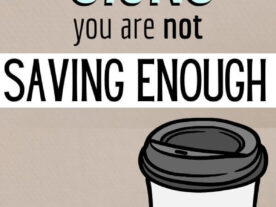6 Warning Signs You are Not Saving Enough
When we make poor decisions with our money, especially when it comes to saving, we limit the choices we can make and risk creating a financial strain that can be avoided.
How are you when it comes to saving? Here are six signs you are not saving enough money to provide for a stable financial future:
1. You Don’t Have Budget
Financial stability (and financial freedom) starts with a budget.
When you create a budget, you decide how you will spend and save your money. If you do not have a plan for your money, it will be nearly impossible to save because it will be spent somewhere. Always.
Here’s how easy creating a budget can be:
- Figure out how much money you have coming in after taxes.
- Total your fixed expenses, like your rent or mortgage, car payments, insurance premiums, and utilities.
- Total expenses that fluctuate, like groceries, entertainment, gas, credit card bills, and clothing.
- Subtract your expenses from your income.
If you have money to spare, then you have money to save for an emergency fund, for a rainy day, or for a special purpose, like a down payment on a home.
Use an App to Make Budgeting a Breeze
If budgeting sounds like too much work, relax. There’s an app for that.
Empower gets you budgeting in two minutes.
Sign up, connect your financial accounts, and create customized budget categories. Empower lets people who hate budgets easily create them.
The service automatically sorts your transactions and notifies you when you’re approaching your spending limit in a given category.
Download Empower to get started with budgeting.
2. You Frequently Look at Your Accounts, but for the Wrong Reasons
Some people check their bank balance all the time because they are OCD (you know who you are).
Others constantly check their accounts to make sure they have money to spend at that moment. If money is in the account, then it’s permission to buy something right then and there.
If you’re frequently checking your account balance with the hope you have money to spend on something, you probably aren’t saving enough.
If you want out of this feast or famine cycle and to save more for your future, the place to start is a budget. Look at where you are spending and look for ways to cut back and save.
Also, establish a savings goal each month. Maybe it’s a percentage of your income or a fixed dollar amount. The key is to start with something that is doable, so you don’t get discouraged.
Get Upside App and Get Cash Back When You Fill Your Tank (and Stomach)
Want cash back when refueling your tank or body? You can with the Upside app, which started as cash-back app for gas and has expanded.
To start saving at the pump, just download the Upside app (formerly GetUpside) and earn cash-back rewards at gas pumps, grocery stores, and appetizing restaurants.
After you install the Upside app, look for cash-back deals and exclusive offers from gas stations, grocers, and restaurants. The Upside app works at 45,000 locations across the United States. Unlike other cash-back apps, this one works at physical locations only.
When you are ready to get cash back, all it takes is a few taps. Open the app, check offers near you and claim your discount. Visit the establishment and after you finish paying with a linked debit or credit card, check in on the app and wait for the rewards.
You can get paid via PayPal, bank account, or gift card. Ready to start earning cash back at nearby stores? Install the Upside app and use the promo code AFF20 to grab a 20 cents-per-gallon sign-up bonus. Did we mention Upside is free?
3. Those Small Purchases Today Means Less Money Available Tomorrow
You know the drill. You shop for 1 item online, then comes the offer to buy $10 more of product to get free shipping or a modest discount. And you bite on the deal and part with more of our cash.
Small purchases add up over time. If you haphazardly spend $3 a day on small, unplanned purchases, that’s about $20 a week, $90 a month, and $1,000 over the course of a year.
Be intentional when you spend. Avoid those small purchases because they can have an enormous impact on what you can save.
Free Workshop – Join our free Simplify Money Workshop
The *only* way to save money is to spend less than you earn. That means you need to decrease your expenses or increase your income.
We want to help you do both.
Join our FREE Simplify Money Workshop to learn the fundamentals of growing wealth. Because when you can spend less than you earn, your money has no choice but to grow. You will build your savings and pay down debt.
What’s more? We’ve got a bunch of free money-hacks to share with you:
- Hacks to lower your monthly bills
- Hacks to spend less on debt
- Hacks to start investing
- Hacks to increase your income by $20/month (with no extra effort)
This workshop has everything you need to accomplish the cardinal rule of personal finance: keep your income over your expenses.
Join our free 5-day Simplify Money Workshop, and start growing your wealth today.
4. Mindless Credit Card Swipes that Wipe Out Future Savings
Credit cards can be a powerful tool in your overall financial strategy, but not when you are mindlessly swiping them to buy things you don’t really need.
When you overspend on a credit today, you will not have money to save in the future because you’ll have to make monthly payments. And, if you carry a balance, you are wasting even more money on interest – money that could be diverted to saving more.
So, before you swipe, have a plan. No more mindless transactions. If you want to avoid the negative trappings of credit and debt, spend with a plan to pay off your balance each month.
Lower Your Debt Interest Rate with a Credit Land Balance Transfer Card
If you have some credit card debt you want to eliminate so you don’t have to keep paying ridiculously high interest rates, consider a Balance Transfer Credit Card.
What is a Balance Transfer Credit Card? It lets you take all your credit card debt and put it onto one card.
Why would you do this? Because balance transfer credit cards offer lower interest rates, sometimes down to 0% APR for 12-18 months (your rates will depend on your credit score). Can you imagine 0% interest for an entire year? What an opportunity to get ahead!
Visit Credit Land Balance Transfer to see which credit card is perfect for you. I.e. the card offering the lowest interest rate ;).
5. Retail Therapy is Not Therapy
Let’s face it, it feels good to spend money and buy new things. But the feeling fades quickly. And then you’re left with less money and stuff you probably don’t need or want. The more you buy, the more clutter you have.
Remember, clutter creates stress just as much as not having money does. So, while you might get a quick fix buying something new, you’re also adding to your stress levels later on.
If you want to break the habit of retail therapy, get clear on what keeps you shopping. What feeling does swiping that card for a new pair of jeans, or a new home decor piece give you?
Identify that and replace the behavior with something that has a positive effect on your life.
6. You Find Too Much Enjoyment in Stuff
We all want nice things. At Budgeting Couple, our aim is to teach you to be smart with your money so you can enjoy life.
But accumulating stuff and doling out your hard-earned cash for all that stuff is not a recipe for enjoying life.
When you derive too much enjoyment from stuff, you are depleting your financial resources, not to mention cluttering your house and life.
You might think you have the liberty to spend your cash on stuff, but there’s no freedom to do the things you want if you don’t have the financial resources.
Having things can be a good thing but strike a balance. Be mindful of what you buy and bring into your home. Do you need it? Does it serve a purpose? Will it make your life better or easier?
Don’t mortgage your future for stuff you don’t really need.
To take saving seriously, embrace these takeaways:
- Create a budget and stick to it.
- Avoid mindless and impulsive purchases ASAP.
- Find enjoyment by embracing life. Not buying stuff.
SAVE MORE MONEY! READ THESE NEXT…
SAVE MONEY AT YOUR FAVORITE STORES:
Want to save these tips for later? Click here to pin this post!
Be sure to follow us on Pinterest for more money-saving life hacks!










